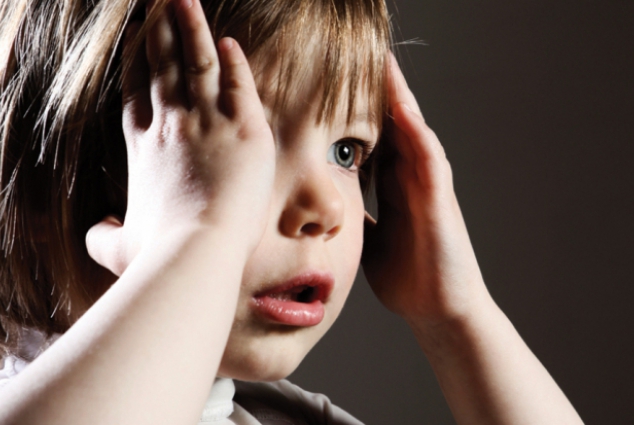The first time I heard the phrase “custody of the eyes,” I was not much older than 6 or 7. I was sitting beside my mom during Mass with her arm draped over my shoulder, one hand gripping me tightly. She was practicing that silent Catholic mom death grip—the one that says, “Be quiet and look straight ahead at the altar.” The task of looking directly ahead would have been easier if my dad weren’t fast asleep at the end of the pew.
I was trying to keep my eyes from his Adam’s apple, which moved slowly up and down. It was as steady as a metronome, and I found it hypnotic. My mom’s grip dug in.
“Look up there,” she whispered. Her free finger pointed to the priest at the altar, who was in the middle of the consecration. “This is the mystery of the Mass. It is very important. You must practice custody of the eyes and pay attention to what’s important.”
I nodded. The death grip released, and I worked hard to watch the priest, his garments, the host held high. My dad’s metronomic Adam’s apple didn’t stop, but I had some success in paying attention to the miracle on the altar despite the distraction.
I know this is not how Catholics generally understand custody of the eyes, if they have been introduced to the phrase at all. Custodia occulorum, or custody of the eyes, is a practice with a long history, exhorted by St. Francis of Assisi and, in its recent past, used as a penance by those pursuing a rigorous spiritual life.
But to the rest of us, it just means holding ourselves accountable for what we choose to look at.
I thought about this after what I call “the GQ cover incident.” The July issue was lying out on the counter, innocently enough (I had thought), though in retrospect I probably should have given it more consideration. There on my kitchen counter, for everyone to see, was swimsuit model Kate Upton in a miniscule bikini.
One of my girlfriends walked by, gasped, and turned it over with a loud smack on the countertop. “Ha!” she snorted. “I love how you just have this lying out!”
“Have what lying out?” I asked. I knew the GQ was there. I was the one who had grabbed it from the mailbox, but truthfully I hadn’t glanced at the cover yet. I flipped the magazine back over and a series of images quickly registered: Kate Upton, tiny bikini, a red, white, and blue popsicle—the wrapper for which would probably cover more of Upton than the bikini itself.
Later, my 3-year-old son would ask me why that girl had a popsicle. His was an innocent question. What he meant was, why does she have a popsicle when I don’t? But it reminded me that images like this would not always be so innocent for him. And perhaps they are not so innocent for me either.
Are the sum total of all the inappropriate images I have seen affecting our lives in small ways I cannot know? How do we hold on to what’s important in light of all these distractions? In short, in what ways am I called to practice custody of the eyes?
Recently at Mass the question of custodial practice presented itself in a different way. During the consecration, a woman cried out for someone to call 9-1-1. Her voice was so filled with visceral panic that I instantly found myself in tears. Immediately a dozen or so people surrounded both her and the man who had toppled over next to her.
The priest on the altar continued with the liturgy of the Eucharist. He paused momentarily, the sleeves of his green robe resting in midair with the host held aloft.
Surely he will stop, I thought. But at the same time I knew he wouldn’t. He continued, and I knew we were meant to as well despite the introduction of a wheelchair and the sounds of an ambulance coming from outside the church doors.
It was yet another challenge to retain custody of the eyes. As I am not a medic, there was nothing for me to do. A hand was offered to me for the Our Father and I took it, begging my eyes to focus on the altar and away from the drama that had moved to the back of church. Even as I let the phrases of the Our Father flow from my mouth, I struggled with Father’s choice to continue Mass.
Similarly, I still struggle with the GQ cover. How restrictive are we called to be? Should I cancel my GQ subscription? Should I stop watching pretty much all the TV shows I currently follow? The practice of custody of the eyes is a tricky one. While I don’t feel drawn to the extreme practices of the saints, I understand the goals of the practice—to see God and his plan for me more clearly.
So the real question is, how many ways do I let what I see interrupt my view of heaven?
At Mass that day, my son grabbed at my legs and reached for me. I gathered him up and let his feet rest on the pew. There on the altar was the Last Supper, one of the last times the apostles would see Christ before he rose into heaven. I knew in that moment what I was called to do.
With the long arm of my mom gripping me, I pointed to the altar and whispered to my son: “Pay attention to what Father’s doing up there. It’s important.”
And for a few moments, he and I both watched as the sounds of the ambulance and everything else distracting our view fell away.
This article appeared in the October 2013 issue of U.S. Catholic (Vol. 78, No. 10, pages 47-48).
Image: ©iStock/Dori OConnell













Add comment